 New on the shelves of the Miller Library is a wonderful book, Flora Illustrata, about the LuEsther T. Mertz Library of the New York Botanical Garden. What makes it so wonderful? Why write a whole book about a library? The editors, Susan M. Fraser and Vanessa Bezemer Sellers, answer these questions in their preface. “We hope that Flora Illustrata captures the wonderful experience of spending an afternoon…among the rustling sound of turning pages, the smell of age-worn paper-worlds of wonder emerging from the heavy sheets.”
New on the shelves of the Miller Library is a wonderful book, Flora Illustrata, about the LuEsther T. Mertz Library of the New York Botanical Garden. What makes it so wonderful? Why write a whole book about a library? The editors, Susan M. Fraser and Vanessa Bezemer Sellers, answer these questions in their preface. “We hope that Flora Illustrata captures the wonderful experience of spending an afternoon…among the rustling sound of turning pages, the smell of age-worn paper-worlds of wonder emerging from the heavy sheets.”
Turning the pages of this particular book reveals a wealth of illustrations ranging from the woodcuts of medieval herbals to the brilliant chromolithographs of 19th century seed catalogs. Other images are selected from the Mertz unmatched collection of books on plants of the Americas in their natural setting, often with their attendant butterflies, birds, and other animals.
While it’s hard to tear one’s eyes away from the illustrations, the text, written by experts in botanical and horticultural literature from America and Europe, provides an excellent and engaging history of the writers and illustrators of the books in the collection. It is also an excellent human history as seen from the perspective of botanists, nursery owners, and home gardeners.
For example, Elizabeth Eustis, a specialist in the art history of gardens, describes mid-19th century advertising depictions of fruit trees which intentionally included flaws such as a brown spot on an otherwise perfect apple. “Although a blemish may seem counter-intuitive as a selling point, it could effectively rebut accusations that such plates were unrealistically idealized.” She goes on to explain that even then, “the deceitful peddler was a familiar stereotype…”
Winner of the 2015 Annual Literature Award from the Council on Botanical and Horticultural Libraries.
Published in Garden Notes: Northwest Horticultural Society, Fall 2015

You may never have wondered about the etymology of vernacular names for plants, but Geoffrey Grigson, author of A Dictionary of English Plant Names (Allen Lane, 1974), has. Why exactly is ‘henbane’ (Hyoscyamus niger) the bane of hens, aside from the fact that it is toxic? It might be because the plant thrives on disturbed or hen-scratched earth, where hens would be more likely to find and consume its poisonous seeds (which will either stun or kill them). [There is a more recent interpretation suggesting that the ancient root hen meant death, but the meaning was lost, and relating the name to domestic fowl filled in the knowledge gap. Source: An Analytic Dictionary of English Etymology by Anatoly Liberman, University of Minnesota, 2008]
The folk history of traditional English plant names is colorful and captivating. ‘Brank-ursine’ is a 15th century name meaning bear’s claw, describing the shape of an Acanthus mollis flower. One common name for Sedum telephium is ‘Midsummer Men,’ originating in a loves-me-loves-me-not game of the 17th century in which cook-maids and dairy-maids placed pairs of stems in chinks in the wall and waited to see if they inclined toward or away from each other. Every time I consult this book I learn something new and fascinating.
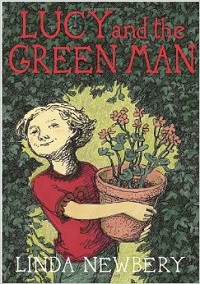
For middle readers, this illustrated chapter book follows Lucy, who loves working in her grandfather’s garden over her school holidays. Together, Lucy and Grandpa Will see a magical Green Man called Lob in the garden. While Lucy is back at school, her grandfather dies suddenly, and Lucy decides to seek the Green Man on her own. Even though she can’t get to Grandpa’s garden, she works to create a space for Lob closer to home. Readers who garden, especially in the city, will reflect on the unique magic that comes of hard work close to home.
Published in the August 2015 Leaflet Volume 2, Issue 8.
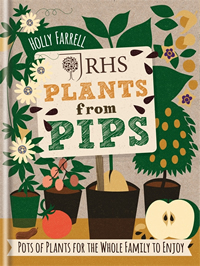 Working in the kitchen, have you ever wondered whether you could grow peppers from pepper seeds? How about a mango tree from a mango pit? This book for gardeners of all ages explains how to germinate a wide range of commonly-seen seeds most people would usually toss in the bin. The entries detail what each plant would need to grow on to maturity, while an illustrated section at the end highlights basic gardening techniques as well as common problems and solutions.
Working in the kitchen, have you ever wondered whether you could grow peppers from pepper seeds? How about a mango tree from a mango pit? This book for gardeners of all ages explains how to germinate a wide range of commonly-seen seeds most people would usually toss in the bin. The entries detail what each plant would need to grow on to maturity, while an illustrated section at the end highlights basic gardening techniques as well as common problems and solutions.
Published in the August 2015 Leaflet Volume 2, Issue 8.
 “Field Guide to Manzanitas” is a nearly comprehensive review of the genus Arctostaphylos, covering 104 of the 105 taxa in the world. Why is one missing? The excellent introduction to this book will answer that question and explore the origins and diversification that has led to one species (Arctostaphylos uva-ursi) being found throughout the northern hemisphere, while 60% of the remaining taxa are considered local endemics within the California Floristic Province. This book is a must for botanizing in California and helpful in making horticultural selections in the Pacific Northwest.
“Field Guide to Manzanitas” is a nearly comprehensive review of the genus Arctostaphylos, covering 104 of the 105 taxa in the world. Why is one missing? The excellent introduction to this book will answer that question and explore the origins and diversification that has led to one species (Arctostaphylos uva-ursi) being found throughout the northern hemisphere, while 60% of the remaining taxa are considered local endemics within the California Floristic Province. This book is a must for botanizing in California and helpful in making horticultural selections in the Pacific Northwest.
Published in the August 2015 Leaflet for Scholars Volume 2, Issue 8.
 “Field Guide to Grasses of California” is an excellent survey of the most common of the 603 taxa, both native and naturalized, in the state. James P. Smith is a professor emeritus of Humboldt State University and his teaching skills are evident throughout. While many species are not found in Washington (only 337 taxa), there is overlap especially with northern California. If you study grasses, this book is well worth reading for its methodology and for a confession (p. 123): “I do not want to discourage you, but you will not be able to identify every grass that you run through the key in this book…” The absolution that follows will lighten the heart of any student botanist.
“Field Guide to Grasses of California” is an excellent survey of the most common of the 603 taxa, both native and naturalized, in the state. James P. Smith is a professor emeritus of Humboldt State University and his teaching skills are evident throughout. While many species are not found in Washington (only 337 taxa), there is overlap especially with northern California. If you study grasses, this book is well worth reading for its methodology and for a confession (p. 123): “I do not want to discourage you, but you will not be able to identify every grass that you run through the key in this book…” The absolution that follows will lighten the heart of any student botanist.
Published in the July 2015 Leaflet for Scholars Volume 2, Issue 7.
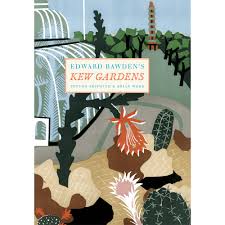 This book defies easy categorization. Bawden was a renowned British illustrator, graphic artist, and painter who served as an official War Artist during World War II. He and his contemporary Eric Ravilious studied with surrealist landscape painter and engraver Paul Nash, and his influence can be felt in Bawden’s lively calligraphic line, and his modernist approach to landscapes and cityscapes. Until exploring this book, I was most familiar with his posters for London Transport, depicting sights and scenes around London.
This book defies easy categorization. Bawden was a renowned British illustrator, graphic artist, and painter who served as an official War Artist during World War II. He and his contemporary Eric Ravilious studied with surrealist landscape painter and engraver Paul Nash, and his influence can be felt in Bawden’s lively calligraphic line, and his modernist approach to landscapes and cityscapes. Until exploring this book, I was most familiar with his posters for London Transport, depicting sights and scenes around London.
The first section of the book reproduces Bawden’s very early manuscript (created when he was just twenty), A General Guide to the Royal Botanic Gardens Kew, Spring and Easter 1923. The second section is a brief but eccentric sociocultural history of Kew, incorporating Kew-inspired illustrations, verse, and humor. The third section is a selection of Bawden’s wry illustrations for Robert Herring’s Adam and Evelyn at Kew. The last section summarizes his lifelong artistic fascination with Kew. Those who are interested in 20th century art and the history of Kew will find it a fascinating book to read and savor.
Reviewed by Rebecca Alexander
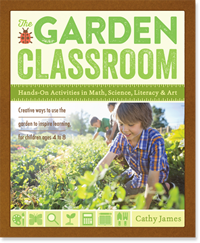 “Anything you can teach in an indoor classroom can be taught outdoors, often in ways that are more enjoyable for children.” This bold assertion opens Cathy James’ new book, and she proves her point with simple steps anyone who teaches children can take to enhance the curriculum outdoors. The projects are flexible, affordable and practical for small or large groups, aged 4 to 8. An invaluable resource for early education!
“Anything you can teach in an indoor classroom can be taught outdoors, often in ways that are more enjoyable for children.” This bold assertion opens Cathy James’ new book, and she proves her point with simple steps anyone who teaches children can take to enhance the curriculum outdoors. The projects are flexible, affordable and practical for small or large groups, aged 4 to 8. An invaluable resource for early education!
Published in the June 2015 Leaflet Volume 2, Issue 6.
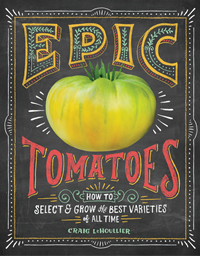 Can you grow “Epic Tomatoes” in the Pacific Northwest? A challenge, perhaps, but this new book by Craig LeHoullier will inspire you to try. Yes, he’s from Raleigh, North Carolina, but he lived in Seattle early in his gardening career. He’s most interested in heirlooms, suggests a rainbow of color options to try (a brown tomato anyone?), encourages you to grow from seed, and enlists the help of regional gardeners in finding the best varieties for our cool summers.
Can you grow “Epic Tomatoes” in the Pacific Northwest? A challenge, perhaps, but this new book by Craig LeHoullier will inspire you to try. Yes, he’s from Raleigh, North Carolina, but he lived in Seattle early in his gardening career. He’s most interested in heirlooms, suggests a rainbow of color options to try (a brown tomato anyone?), encourages you to grow from seed, and enlists the help of regional gardeners in finding the best varieties for our cool summers.
Published in the June 2015 Leaflet Volume 2, Issue 6.
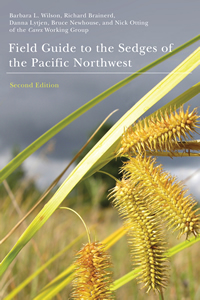 “Field Guide to Sedges of the Pacific Northwest” is regarded by reviewers across the country as one of the best field guides on any topic, and is even better in the newly released 2nd edition. Included are entries for all 169 species, subspecies, and varieties that grow wild in Oregon and Washington, with typically 4-6 photographs or diagrams of each. An extensive key helps with identification, as do detailed tips with each entry, while comments discuss habitat, ethnobotanical uses, and the significance for restoration.
“Field Guide to Sedges of the Pacific Northwest” is regarded by reviewers across the country as one of the best field guides on any topic, and is even better in the newly released 2nd edition. Included are entries for all 169 species, subspecies, and varieties that grow wild in Oregon and Washington, with typically 4-6 photographs or diagrams of each. An extensive key helps with identification, as do detailed tips with each entry, while comments discuss habitat, ethnobotanical uses, and the significance for restoration.
Published in the June 2015 Leaflet for Scholars Volume 2, Issue 6.
 New on the shelves of the Miller Library is a wonderful book, Flora Illustrata, about the LuEsther T. Mertz Library of the New York Botanical Garden. What makes it so wonderful? Why write a whole book about a library? The editors, Susan M. Fraser and Vanessa Bezemer Sellers, answer these questions in their preface. “We hope that Flora Illustrata captures the wonderful experience of spending an afternoon…among the rustling sound of turning pages, the smell of age-worn paper-worlds of wonder emerging from the heavy sheets.”
New on the shelves of the Miller Library is a wonderful book, Flora Illustrata, about the LuEsther T. Mertz Library of the New York Botanical Garden. What makes it so wonderful? Why write a whole book about a library? The editors, Susan M. Fraser and Vanessa Bezemer Sellers, answer these questions in their preface. “We hope that Flora Illustrata captures the wonderful experience of spending an afternoon…among the rustling sound of turning pages, the smell of age-worn paper-worlds of wonder emerging from the heavy sheets.”

 Working in the kitchen, have you ever wondered whether you could grow peppers from pepper seeds? How about a mango tree from a mango pit? This book for gardeners of all ages explains how to germinate a wide range of commonly-seen seeds most people would usually toss in the bin. The entries detail what each plant would need to grow on to maturity, while an illustrated section at the end highlights basic gardening techniques as well as common problems and solutions.
Working in the kitchen, have you ever wondered whether you could grow peppers from pepper seeds? How about a mango tree from a mango pit? This book for gardeners of all ages explains how to germinate a wide range of commonly-seen seeds most people would usually toss in the bin. The entries detail what each plant would need to grow on to maturity, while an illustrated section at the end highlights basic gardening techniques as well as common problems and solutions. “Field Guide to Manzanitas” is a nearly comprehensive review of the genus Arctostaphylos, covering 104 of the 105 taxa in the world. Why is one missing? The excellent introduction to this book will answer that question and explore the origins and diversification that has led to one species (Arctostaphylos uva-ursi) being found throughout the northern hemisphere, while 60% of the remaining taxa are considered local endemics within the California Floristic Province. This book is a must for botanizing in California and helpful in making horticultural selections in the Pacific Northwest.
“Field Guide to Manzanitas” is a nearly comprehensive review of the genus Arctostaphylos, covering 104 of the 105 taxa in the world. Why is one missing? The excellent introduction to this book will answer that question and explore the origins and diversification that has led to one species (Arctostaphylos uva-ursi) being found throughout the northern hemisphere, while 60% of the remaining taxa are considered local endemics within the California Floristic Province. This book is a must for botanizing in California and helpful in making horticultural selections in the Pacific Northwest. “Field Guide to Grasses of California” is an excellent survey of the most common of the 603 taxa, both native and naturalized, in the state. James P. Smith is a professor emeritus of Humboldt State University and his teaching skills are evident throughout. While many species are not found in Washington (only 337 taxa), there is overlap especially with northern California. If you study grasses, this book is well worth reading for its methodology and for a confession (p. 123): “I do not want to discourage you, but you will not be able to identify every grass that you run through the key in this book…” The absolution that follows will lighten the heart of any student botanist.
“Field Guide to Grasses of California” is an excellent survey of the most common of the 603 taxa, both native and naturalized, in the state. James P. Smith is a professor emeritus of Humboldt State University and his teaching skills are evident throughout. While many species are not found in Washington (only 337 taxa), there is overlap especially with northern California. If you study grasses, this book is well worth reading for its methodology and for a confession (p. 123): “I do not want to discourage you, but you will not be able to identify every grass that you run through the key in this book…” The absolution that follows will lighten the heart of any student botanist. This book defies easy categorization. Bawden was a renowned British illustrator, graphic artist, and painter who served as an official War Artist during World War II. He and his contemporary Eric Ravilious studied with surrealist landscape painter and engraver Paul Nash, and his influence can be felt in Bawden’s lively calligraphic line, and his modernist approach to landscapes and cityscapes. Until exploring this book, I was most familiar with his posters for London Transport, depicting sights and scenes around London.
This book defies easy categorization. Bawden was a renowned British illustrator, graphic artist, and painter who served as an official War Artist during World War II. He and his contemporary Eric Ravilious studied with surrealist landscape painter and engraver Paul Nash, and his influence can be felt in Bawden’s lively calligraphic line, and his modernist approach to landscapes and cityscapes. Until exploring this book, I was most familiar with his posters for London Transport, depicting sights and scenes around London. “Anything you can teach in an indoor classroom can be taught outdoors, often in ways that are more enjoyable for children.” This bold assertion opens Cathy James’ new book, and she proves her point with simple steps anyone who teaches children can take to enhance the curriculum outdoors. The projects are flexible, affordable and practical for small or large groups, aged 4 to 8. An invaluable resource for early education!
“Anything you can teach in an indoor classroom can be taught outdoors, often in ways that are more enjoyable for children.” This bold assertion opens Cathy James’ new book, and she proves her point with simple steps anyone who teaches children can take to enhance the curriculum outdoors. The projects are flexible, affordable and practical for small or large groups, aged 4 to 8. An invaluable resource for early education! Can you grow “Epic Tomatoes” in the Pacific Northwest? A challenge, perhaps, but this new book by Craig LeHoullier will inspire you to try. Yes, he’s from Raleigh, North Carolina, but he lived in Seattle early in his gardening career. He’s most interested in heirlooms, suggests a rainbow of color options to try (a brown tomato anyone?), encourages you to grow from seed, and enlists the help of regional gardeners in finding the best varieties for our cool summers.
Can you grow “Epic Tomatoes” in the Pacific Northwest? A challenge, perhaps, but this new book by Craig LeHoullier will inspire you to try. Yes, he’s from Raleigh, North Carolina, but he lived in Seattle early in his gardening career. He’s most interested in heirlooms, suggests a rainbow of color options to try (a brown tomato anyone?), encourages you to grow from seed, and enlists the help of regional gardeners in finding the best varieties for our cool summers. “Field Guide to Sedges of the Pacific Northwest” is regarded by reviewers across the country as one of the best field guides on any topic, and is even better in the newly released 2nd edition. Included are entries for all 169 species, subspecies, and varieties that grow wild in Oregon and Washington, with typically 4-6 photographs or diagrams of each. An extensive key helps with identification, as do detailed tips with each entry, while comments discuss habitat, ethnobotanical uses, and the significance for restoration.
“Field Guide to Sedges of the Pacific Northwest” is regarded by reviewers across the country as one of the best field guides on any topic, and is even better in the newly released 2nd edition. Included are entries for all 169 species, subspecies, and varieties that grow wild in Oregon and Washington, with typically 4-6 photographs or diagrams of each. An extensive key helps with identification, as do detailed tips with each entry, while comments discuss habitat, ethnobotanical uses, and the significance for restoration.